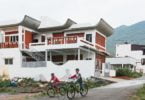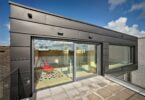Conventional design only welcomes a certain type of person: the one arbitrarily deemed “normal.” It’s easy for designers, or even the casual observer, to define the most typical user of a space as one who requires no modifications in order to access it. But “normal” doesn’t really exist, and you can’t necessarily tell by looking at someone whether they’re having a lot of trouble heaving open a heavy door, struggling to mount stairs, feeling confused by a complex access system or excluded from using it altogether. In that sense, the appearance of being “typical” is useless, just like the space you’ve created is to a large segment of people who might otherwise want or need to participate. That’s where Universal Design comes in.

Universal Design vs Conventional Design
The Disability Act of 2005 defines Universal Design as “the design and composition of an environment so that it may be accessed, understood and used to the greatest possible extent, in the most independent and natural manner possible, in the widest possible range of situations, without the need for adaptation, modification, assistive devices or specialized solutions, by any persons of any age or size or having any particular physical, sensory, mental health or intellectual ability or disability.” In electronic systems, it also means designing “any electronics-based process of creating products, services or systems so that they may be used by any person.”
In 1997, a group of architects, product engineers, engineers and environmental design researchers developed seven principles of Universal Design to help guide their professions in meeting these goals. To summarize:
- The design is useful and marketable to people with diverse abilities.
- The design accommodates a wide range of individual preferences and abilities.
- Use of the design is easy to understand, regardless of the user’s experience, knowledge, language skills, or current concentration level.
- The design communicates necessary information effectively to the user, regardless of ambient conditions or the user’s sensory abilities.
- The design minimizes hazards and the adverse consequences of accidental or unintended actions.
- The design can be used efficiently and comfortably and with a minimum of fatigue.
- Appropriate size and space is provided for approach, reach, manipulation, and use regardless of user’s body size, posture, or mobility.
Universal Design doesn’t necessarily set out to create a “one size fits all” solution, but rather to push the boundaries of “mainstream” products, services and environments to include as many people as possible, and provide the ability for customization to minimize the difficulties of particular users. That may sound like a tall order, but the key is that no single designer can ever successfully pull it off alone.
How to Begin Making Universal Design Spaces More Inclusive
To start, Universal Design means going beyond legal accessibility requirements to serve as many people as possible without segregating those with different needs. Putting it into action might mean altering a building that has stairs at the front entrance and an accessible entrance in the back to offer a single entrance for everyone to use. Most of the time, this can be done without affecting the overall integrity of the design. After all, most able-bodied people don’t mind walking up a ramp instead of using stairs. This approach to design works for “virtually” everyone, but there are also ways to accommodate the people who tend to fall through the cracks implied in this statement.
To start, Universal Design means going beyond legal accessibility requirements to serve as many people as possible without segregating those with different needs. Putting it into action might mean altering a building that has stairs at the front entrance and an accessible entrance in the back to offer a single entrance for everyone to use. Most of the time, this can be done without affecting the overall integrity of the design. After all, most able-bodied people don’t mind walking up a ramp instead of using stairs. This approach to design works for “virtually” everyone, but there are also ways to accommodate the people who tend to fall through the cracks implied in this statement.

Inclusive design is “a methodology that enables and draws on a full range of human diversity,” says designer Kat Holmes, author of a book on inclusive design called “Mismatch.” Ideally, the two approaches would work together to produce objects, experiences and spaces that are accessible to the greatest possible number of people. (By the way, many disability justice activists prefer use of the word “accessible” to describe the resulting spaces rather than “handicap.”)
Examples of Universal Design
So what does all this mean in the real world? Often, the changes required to accommodate and include more people are simple. Placing standard electrical receptacles higher on the walls, selecting wider doorways that can fit wheelchairs and people of all sizes, making entrances flat, installing louver door handles and creating storage spaces that are within reach of people of all heights are some examples offered by the Accessible Society. When more than one option is available for a design feature, choose the one that’s the most inclusive – or lead the charge in demanding a new one.
But Universal Design also means adapting both existing architecture and new building projects to recognize the vast array of abilities, limitations and differences that exist within our communities. To really embrace it, designers, architects and planners must challenge their assumptions of what the “normal” usage of a space will be, particularly since so many disabilities can be invisible to the casual observer. Here are some examples of what that can look like.






